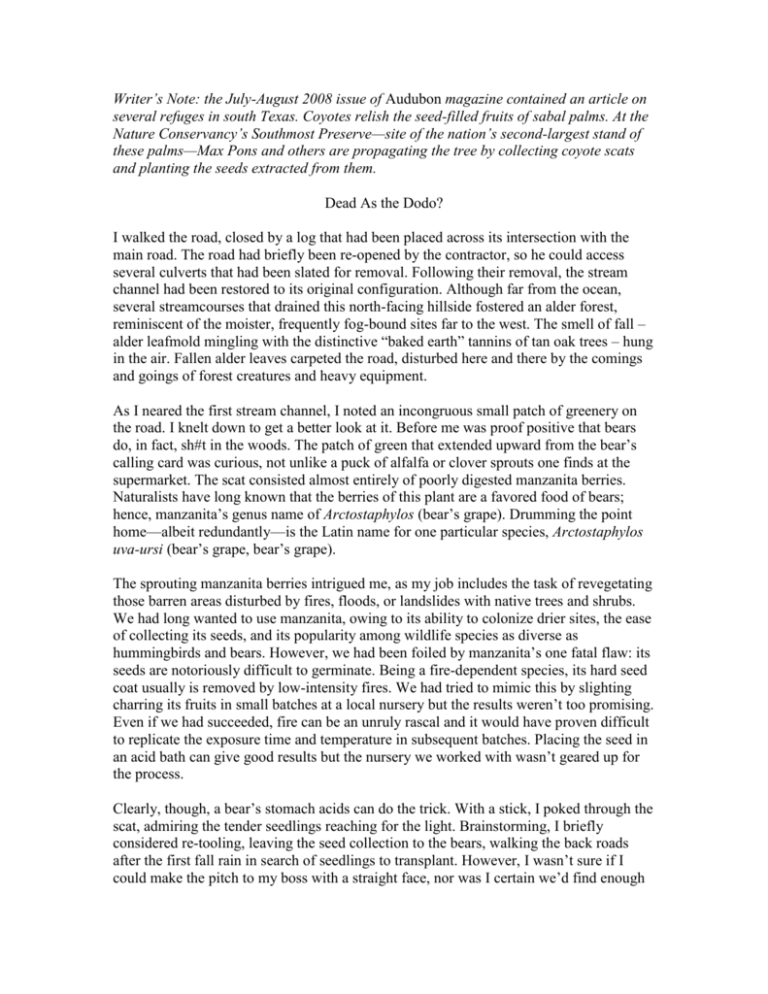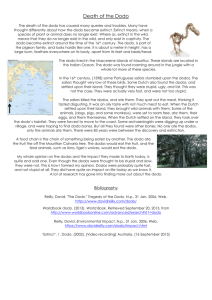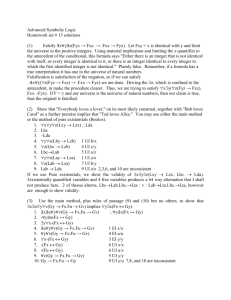Dead As the Dodo - Sterling Wildlife Biology
advertisement

Writer’s Note: the July-August 2008 issue of Audubon magazine contained an article on several refuges in south Texas. Coyotes relish the seed-filled fruits of sabal palms. At the Nature Conservancy’s Southmost Preserve—site of the nation’s second-largest stand of these palms—Max Pons and others are propagating the tree by collecting coyote scats and planting the seeds extracted from them. Dead As the Dodo? I walked the road, closed by a log that had been placed across its intersection with the main road. The road had briefly been re-opened by the contractor, so he could access several culverts that had been slated for removal. Following their removal, the stream channel had been restored to its original configuration. Although far from the ocean, several streamcourses that drained this north-facing hillside fostered an alder forest, reminiscent of the moister, frequently fog-bound sites far to the west. The smell of fall – alder leafmold mingling with the distinctive “baked earth” tannins of tan oak trees – hung in the air. Fallen alder leaves carpeted the road, disturbed here and there by the comings and goings of forest creatures and heavy equipment. As I neared the first stream channel, I noted an incongruous small patch of greenery on the road. I knelt down to get a better look at it. Before me was proof positive that bears do, in fact, sh#t in the woods. The patch of green that extended upward from the bear’s calling card was curious, not unlike a puck of alfalfa or clover sprouts one finds at the supermarket. The scat consisted almost entirely of poorly digested manzanita berries. Naturalists have long known that the berries of this plant are a favored food of bears; hence, manzanita’s genus name of Arctostaphylos (bear’s grape). Drumming the point home—albeit redundantly—is the Latin name for one particular species, Arctostaphylos uva-ursi (bear’s grape, bear’s grape). The sprouting manzanita berries intrigued me, as my job includes the task of revegetating those barren areas disturbed by fires, floods, or landslides with native trees and shrubs. We had long wanted to use manzanita, owing to its ability to colonize drier sites, the ease of collecting its seeds, and its popularity among wildlife species as diverse as hummingbirds and bears. However, we had been foiled by manzanita’s one fatal flaw: its seeds are notoriously difficult to germinate. Being a fire-dependent species, its hard seed coat usually is removed by low-intensity fires. We had tried to mimic this by slighting charring its fruits in small batches at a local nursery but the results weren’t too promising. Even if we had succeeded, fire can be an unruly rascal and it would have proven difficult to replicate the exposure time and temperature in subsequent batches. Placing the seed in an acid bath can give good results but the nursery we worked with wasn’t geared up for the process. Clearly, though, a bear’s stomach acids can do the trick. With a stick, I poked through the scat, admiring the tender seedlings reaching for the light. Brainstorming, I briefly considered re-tooling, leaving the seed collection to the bears, walking the back roads after the first fall rain in search of seedlings to transplant. However, I wasn’t sure if I could make the pitch to my boss with a straight face, nor was I certain we’d find enough scat to make it worth our while. After I was through inspecting the restored stream channels, I headed back toward the truck. Seeing the sprouting manzanita reminded me of a tale I’d recently heard, a parable of interconnectedness, where behind-the-scene processes, if disturbed, often reap unforeseen consequences… That the tale of the Dodo bird is well known among naturalists and those with scant interest in the natural world alike underscores it status as the most famous extinct bird in the world. In 1515, the Portuguese became the first humans to set foot on the island of Mauritius. The Dodo, endemic to the island, began to experience the extent of human impact with the arrival of the Dutch in 1589. Located in the Indian Ocean between Madagascar and the west coast of Australia, Mauritius lies 1200 miles off the coast of East Africa, far from any continent or neighbor island. It is situated 550 miles east of the island of Madagascar and is 809 square miles in size. At the time of European contact, Mauritius had no indigenous land mammals or amphibians. Dodos were descendents of a type of pigeon that arrived in Mauritius over 4 million years ago. Over time, two species of Dodos evolved, one on Mauritius and the other on Rodrigues Island, located 350 miles to the northeast. As is common among birds that colonize islands far from continental land masses, the Dodo – having no terrestrial predators – over time, lost its ability to fly. The isolation of its island location helped form a creature with no fear of humans. Hungry sailors interpreted this lack of fear as stupidity, dubbing the bird "dodo" (a simpleton in the Portuguese tongue). Just over 3 feet long and averaging 30 pounds, large numbers of Dodos were killed for food. Dodos nested on the ground, laying a single egg in a thick nest of grass. Sailors' journals from the early 1600s reported that the mother raised the young and protected the nest with fierce bites from her thick, large beak. A combination of factors – familiar to those who study island ecosystems – led to the Dodo’s demise. In the 19th century, the dense Mauritian forests were converted into tea and sugar plantations. The island quickly became a stopover for ships engaged in the spice trade. Sailors brought animals with them, including cats, and rats. Later, when the Dutch used the island as a penal colony, pigs and monkeys came to the island along with the convicts. Rats, pigs, and monkeys made short work of vulnerable dodo eggs and nestlings. Of the 45 bird species originally found on Mauritius, only 21 have managed to survive. Once abundant, the last confirmed sighting of a Dodo was in 1662. However, it is now believed that undetected Dodos finally went extinct in 1690. One would think that this is the end of the story, right? Well, no. Sideroxylon grandiflorumis is a long-lived tree endemic to Mauritius. Formerly known as Calvaria major, its common name is tambalacoque. In the early 1970s, the species was on the brink of extinction, as only 13 spindly specimens survived in the wild. Because the once-common tree had served as a useful source of timber for island residents, Mauritian foresters began to study the tambalacoque, with the hope of identifying the reasons for its decline. Researchers believed that the age of all the remaining trees -- about 300 years old – was the reason for their poor condition. The elderly trees still produced seeds but none germinated, even when carefully tended under ideal nursery conditions. Enter Stanley Temple, a scientist in the department of wildlife ecology at the University of Wisconsin, Madison. During his discussions with Mauritian foresters, some opined that the advanced age of the trees prevented them from producing healthy seeds. Temple disagreed, for several reasons. Number one, the seeds and fruits showed no visible defects, as would occur if the trees were too old to produce viable seed. Also, if advanced age was the problem, the trees would have produced viable seeds when they were younger. However, there were no seedlings, saplings, or younger trees to show that tambalacoque seeds had sprouted successfully in the past 300 years. Temple was aware of the delicate balancing act that nature must exercise in the production of viable seeds. Namely, they must be capable of resisting the forces of decay, delaying germination until conditions warrant. A variety of plants accomplish this by enveloping their seeds with a durable, waterproof coating. Fire ecology plants rely on light-intensity fire, while passing through an animal’s gut enhances some plants’ germination. Some plants in desert regions lie in wait for the next flood, when the seed is propelled downstream, abrasion from rocks nicking the seed coat. Clearly, a dramatic environmental change had occurred approximately 300 years ago on the island of Mauritius. Temple correctly identified the watershed event: the extinction of the Dodo. Evidence for his theory came from several sources. Fossil tambalacoque pits had been found among the skeletal remains of Dodos. Sailors’ journals indicated that Dodos aided digestion by swallowing small stones, which were used by the Dutch sailors to sharpen their knives. One of these stones, nearly an inch and a half in length, consisting of extremely hard volcanic rock, is in the Cambridge University museum in England. Lacking Dodos, Temple procured a flock of turkeys to test his theory. They had no interest in eating whole fruit but they cooperated by eating the pits. With the help of turkey gizzards, a few tambalacoque seeds sprouted, the first seen on Mauritius in three centuries. Foresters now scrape the pits by hand to get them to sprout, rather than feeding them to turkeys. Temple’s theory that the tree required the Dodo has been debated; others have suggested that other extinct animals may also have been distributing the seeds. Although it is too late for the Dodo, the tambalacoque tree appears to be on the road to recovery. Lessons abound: the fragility of island ecosystems and the devastating effects of habitat conversion and introduced terrestrial predators. Perhaps the most important lesson to be learned, however, is the interdependency of organisms; in this case, the coevolution of the Dodo and the tambalacoque tree. Hopefully, Sideroxylon grandiflorumis— now known as the “Dodo tree”—will prosper, never to be described as “dead as the Dodo.”








